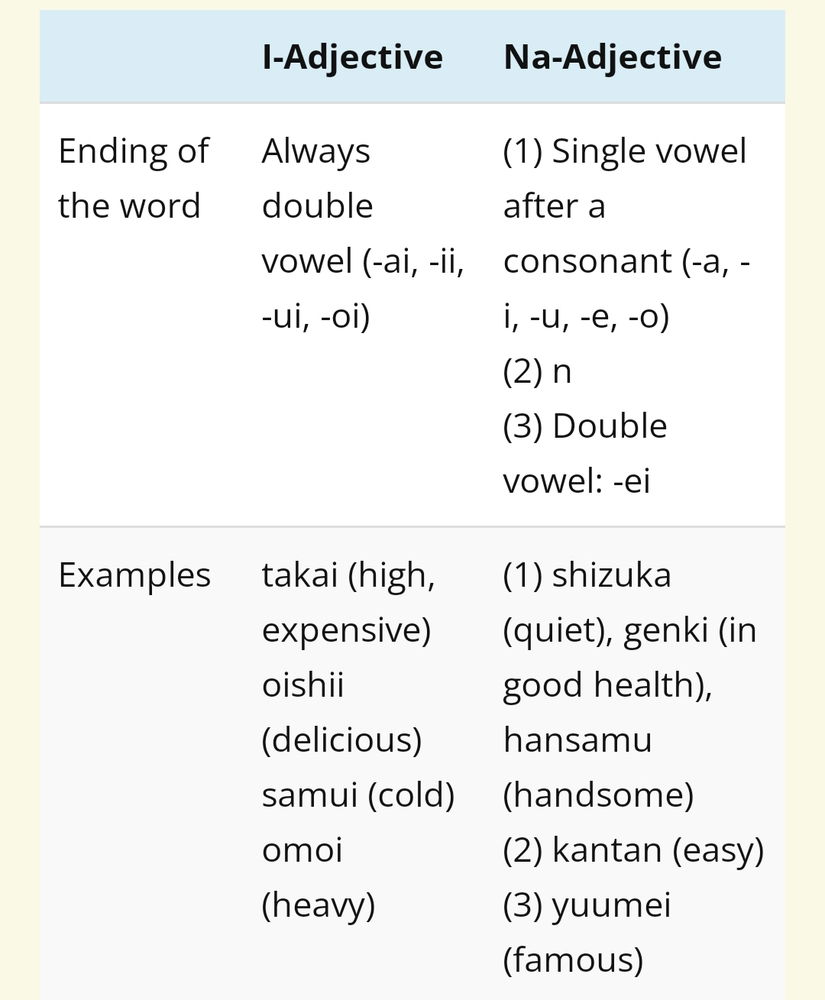C is A and B
16
部屋は暗くて汚いです。
The room is dark and dirty.
0
26
拉麺は熱くて美味しいです。
Ramen is hot and delicious.
0
9
此れは古くて重いテレビです。
This is an old and heavy TV.
0
12
其処は安全で素敵な所です。
That is a safe and wonderful place.
0
14
其れは複雑で大変な仕事です。
That is a complex and tough job.
0
8
此処は静かで怖いです。
This place is quiet and scary.
0
15
此のステーキは分厚くて美味しいよ!
This steak is thick and delicious!
0
6
彼のカクテルは甘くて飲みやすい。
That cocktail is sweet and easy to drink.
0
13
此処は涼しくていい。
It is nice and cool here.
0
14
其処は迚も大きくて賑やかな都市だ。
It's a very big and busy city.
0
6
其の湖は大きくて美しい。
The lake is large and beautiful.
0
10
其の部屋は広くて明るい。
The room is spacious and bright(ly lit).
2
9
其れは大きくて黒い亜米利加の軍艦だった。
It was a big black American warship.
0
11
青白くて暗い顔を為た人物だった。
She was a pale, gloomy-faced person.
0
2
彼は背が高くて強い人です。
He is a tall and strong person.
0
12
日の光が強くて暖かい。
The sun's light is strong and warm.
0
Getting the sentences
List

げんき(な)
げんきじゃない
What if you wanted to use an adjective in a negative sense (not new, not cute, not young, etc.)? You can conjugate them!
な-adjectives conjugate with the “suffix” じゃない.
Take the adjective げんき(な)(it means energetic).
To make it negative, you will drop the な and add じゃない.
げんき じゃない せんせい
きれい じゃない つくえ
You can then work with this adjective like normal (by placing it in front of a noun).
You can then work with this adjective like normal (by placing it in front of a noun).
So this is a “not” energetic (un-energetic) teacher.
This is a not-clean desk (a desk that is not clean).
These may sound awkward in English, but they are very natural to use in Japanese!
あたらしい
あたらしくない
かわいい
かわいくない
い-adjectives work in a slightly different way - instead of じゃない, they become negative using くない.
い-adjectives work in a slightly different way - instead of じゃない, they become negative using くない.
You will drop the final い when you add くない.
So あたらしくない is “not new”.
This is “not cute”.
いい → よくない
There is only one irregular adjective in Japanese, and it is いい (good).
When いい conjugates, it acts as if it were よい、so in the negative, it becomes よくない.
よくない がくせい
あたらしくない いえ
かわいくない ねこ
Let’s see some examples with nouns.
Let’s see some examples with nouns.
This is a not-good student.
And this is a not-new house.
Lastly, a not-cute cat. (As if there was such a thing!)
ふるい → ふるくて
あおい → あおくて
すばらしい → すばらしくて
あおい → あおくて
すばらしい → すばらしくて
You’re doing great! Let’s tackle one more way of using adjectives.
You’re doing great! Let’s tackle one more way of using adjectives.
If you want to use two or more adjectives in succession (like a cute, famous, yellow cat), you will conjugate adjectives there too.
い-adjectives will drop the い like before, and add くて.
As mentioned before, いい will conjugate as if it were よい, becoming よくて.
ちいさくなくて
しずかじゃなくて
しずかじゃなくて
You can also use negative adjectives - な or い - the same way.
You can also use negative adjectives - な or い - the same way.
Just remove the い at the end and add くて!
ひま → ひまで
すてき → すてきで
いや → いやで
すてき → すてきで
いや → いやで
な-adjectives will conjugate by dropping the な and adding で.
な-adjectives will conjugate by dropping the な and adding で.
かわいくて、ゆうめいで、きいろい ねこ
This is a cute, famous, yellow cat!
This is a cute, famous, yellow cat!
Once you get these adjective spelling rules down, your sentences will get quite a nice boost!
Construction
(Elements in parentheses are optional.)
Basic Examples:
高くて大きい本 (an expensive, big book)
有名で賑やかな町 (a famous, lively town)
Where this grammar is found
Grammar usage notes
Nothing posted yet!
Questions/Discussion
Nothing posted yet!





